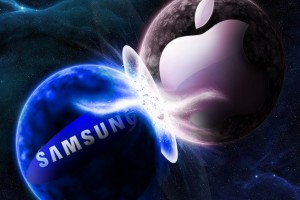A nine-person California jury will begin their deliberations Wednesday in the landmark patent battle between Apple and Samsung. The case, which has been argued since the beginning of the month, pits two of the world’s largest electronics makers against each other and could result in billions of dollars in fines depending on the jury’s decision.
The case revolves around a handful of patents covering the look and feel of the iPhone and iPad and some of the icons on the devices’ home screens. It’s one of several legal battles the companies are fighting around the world but, given its location in the heart of Silicon Valley and close to Apple’s Cupertino headquarters, it is perhaps the most closely watched.
Lawyers for Apple and Samsung spent their final afternoon in front of the jury Tuesday making their closing arguments.
During a 75-minute presentation, Apple lawyer Harold McElhinny reviewed some of the many hundreds of pages of evidence and testimony produced during the case and presented them as evidence that Samsung deliberately sought to produce what McElhinny called “iPhone knock-offs.”
The documents included an internal Samsung analysis produced in 2007 that discusses the iPhone’s strengths and press reports that trumpeted the iPhone’s “revolutionary” design.
“In 2007, Steve Jobs shocked the phone world,” McElhinny said. “A four-year effort had paid off. Apple turned over its future to designers and they came up with the iPhone.”
Apple alleges that Samsung has sold 22.7 million cellphones in the U.S. since June 2010 that infringe on Apple’s patents and, as such, argues that Samsung should be made to pay up to $2.75 billion in damages.
“Samsung makes fun of our damages claim. They make fun of us for asking for billions of dollars,” McEhinny said. “The damages should be large because the infringement is massive.”
If the jury decides there was infringement and that it was deliberate and wilful, the judge in the case could triple the award.
Samsung lawyer Charles Verhoeven didn’t argue that the phones weren’t similar. Instead, he countered that similarities in the design were due to natural product evolution in the phone industry and that no evidence was presented showing consumers being confused by phones from the two companies.
“The reason they didn’t provide any evidence is because there is none,” he said. Apple is “asking you to prevent its biggest competitor from giving consumers what they want — smartphones with big screens.”
Verhoeven framed the case as a battle that could affect the entire business of innovation in the U.S.
“The real reason Apple is bringing this case is because rather than compete in the marketplace, Apple is seeking a competitive edge in the courtroom.”
Verhoeven told the jury that no damages are due because there was no infringement, but if they disagree and decide money should be paid then they shouldn’t pay attention to Apple’s figures because they are based on revenue and not profit.
The closing arguments followed a morning in which the jury was read more than 100 pages of instructions for its deliberations. The case also involves two of Samsung’s U.S. business units and alleges infringement by more than 20 of its handsets on some points. As a result, the jury faces more than 700 decisions on its verdict form.
The case, number 11-01846, is between Apple and Samsung in the U.S. District Court for the Northern District of California.






